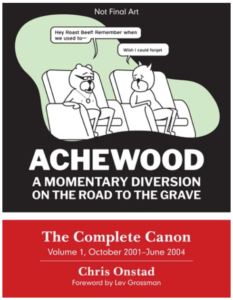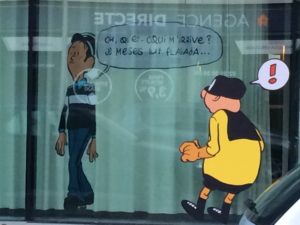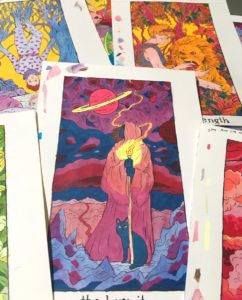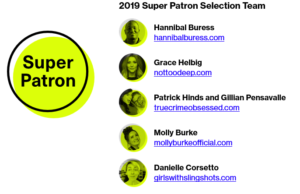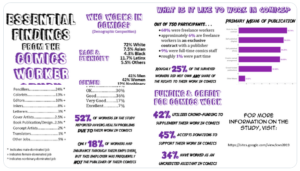The meetup took place Friday at 1:30 PM. Fun fact: the event started a bit late, and while waiting for it to start my neighbor, a child who was no more than ten, asked me what I was doing, and I genuinely explained my role as accredited media, with my setup and how it allowed me to pseudojournalize: an iPhone on a table tripod to take photos, and an iPad on a stand with a keyboard to take notes. I may have omitted the pseudo part. I was able to finish my explanations, and the event started shortly thereafter.
The meetup began by an introduction of Imbattable, the only genuine comic book superhero.
Wassmer: Jousselin has two showcases of his work: one exhibition on how comics are created, and one story to follow in town, which can only be seen on location, of which we see the beginning here. What was the process for that story?
Jousselin: He created it with the help of Régis Thomas, and wanted to create something that could only be done on this particular location. It starts in the hall of the building La Grande Passerelle, near the library entrance. He started by spotting the location in June to see how the city space could be used.
Wassmer: To play with the volumes, in a fashion.
Jousselin: He did not necessarily saw it that way, but indeed. One constraint was the need to introduce the series to unfamiliar readers, so the focus was on the main two characters, for instance eschewing Toudi¹.
Wassmer: Jousselin is local, being based in Rennes, and has worked with co-creators as well as by himself, how does he see his 20 years career in comics?
Jousselin: He’s very happy of it, he feels lucky Dupuis is trusting him with this character of him.
Wassmer: Is there any kind of thematic continuity between his stories?
Jousselin: In a way; he works quite slowly, so he focuses on what really interests him, rather than spreading himself too thin.
Wassmer: Here we have his first published work, a collaboration with Brüno.
Jousselin: It came up between them: What if we collaborated on something?, but they weren’t living in the same town, so what if they did an exquisite corpse? They stuck to the constraint in that they did not even mention the project when they would happen to meet. But he made sure that the reader wouldn’t get lost, which was more important than these creative constraints.
Wassmer: So would he say all his works have some sort of constraint? Any relationship with the OULIPO?
Jousselin: It depends, sometimes there is such a constraint from the start, sometimes it is added as he goes. Sequential art is a constraint: since the reader can see every panel at a glance, he must make sure to compartimentalize to preserve the suspense, for instance.
Wassmer: Now we have another book; what was the constraint here?
Jousselin: It was the kind of comic book where the constraint was implicit, here being that all four stories were around music, with each one being named for a standard. Furthermore, the stories interact, with characters from one making a cameo in the background of another for instance.
Wassmer: Another work, the Atelier Mastodonte; were the constraints any different here?
Jousselin: Mostly telling stories together, and friendly competition between colleagues. It tells the daily work of creators as if they were working together in a single studio.
Wassmer: A collective project, then, rather than teamwork; does it feel any different?
Jousselin: Trondheim invited him, and he gladly accepted as he already appreciated the work as a reader, and he’s always up for making books.
Wassmer: And now we get to Colt Bingers.
Jousselin: For this one he paired with a studiomate with which he wanted to work. For this story in particular he needed a style different from his own.
Wassmer: Was it hard to let go of the drawing part?
Jousselin: Even though the main reason for this delegation being the artist being able to draw in a way he isn’t able to, it was indeed difficult for him. He strived when writing the script to avoid restricting his artist, for instance by avoiding any composition indication, with only limited exceptions.
Wassmer: Now here this strip is also the opportunity to pay an homage, it seems.
Jousselin: Indeed, here to Alfred, since he can do both humor and gravitas². Jousselin admits Alfred is also the only creator contributing the Atelier Mastodonte he personally knew.
Wassmer: What process does Jousselin follow for telling stories?
Jousselin: He has always read comics, first classics such as Tintin, Spirou, Astérix, then as a teenager Fred and Gotlib.
Wassmer: Were those his inspirations for innovative narration?
Jousselin: In this regard, Fred and Marc-Antoine Mathieu have influenced him in particular, then Windsor McCay, and even Hergé, with for instance a Quick and Flupke gag having a character practicing winter sports and ending up running into a panel border. Sequential art is its own language, and as opposed to projects could be created elsewhere such as as a movie, he want to create works relying on the specific language of sequential art.
Wassmer: We can now see another strip of him.
Jousselin: He needs his character to easily be drawn consistently, mostly visible here with his outfit³, in case he needs to be draw by another. Already we can see the timing would not work as well in animation, here the waffle iron layout, i.e. the regular spacing of panels, allows the importance to be equally given to all panels, it would be harder to express in animation especially if movement was involved.
Wassmer: And now we get to Imbattable, with this cover of the Spirou weekly anthology.
Jousselin: He was born without even planning for it, Jousselin created the first two pages by himself, and thought that Spirou could be interested even if he did not know anyone there. He sent the pages, they answered, he then quickly added that such a minimal concept wouldn’t last longer than ten pages … but as it went he quickly realized the concept was wider and also allowed for multipage stories, and he ended up being able to set the pace of publishing.
Wassmer: Then it was collected in a book, with the cover visible here.
Jousselin: The Spirou anthologies are not reprinted, so it’s better for his work to end up in books, but he hesitated for fear of it drying up after 60 pages or so, which would have made it hard to justify starting a book series, so he hesitated but it ended up happening.
Wassmer: Are there any particular influences in Imbattable?
Jousselin: He instinctively mixed what he likes as a creator: Chris Ware for instance, but he never gave up on Hergé, Spirou, etc. The mix happens unconsciously. Then there is the need to maintain a slightly dated Fench-Belgian-style decorum, by influence of being published in Spirou.
Wassmer: Superman watches over the world, Spider-Man his neighborhood, but what about Imbattable?
Jousselin: There is no feat too small for Imbattable, whether it be helping a neighborhood, the world, or a granny, he does it.
Wassmer: How did Jousselin come up with his costume and physical appearance?
Jousselin: He can’t easily recall; he’d probably have done differently if he’d intended it to be a series from the start. Instead the first pages were created as a distraction, so he went by instinct when designing the costume. The only indication that was given to the colorist was to use yellow and black to maximize contrast: given the mundane setting it was necessary to dynamize the hero’s look.
Wassmer: Then what is the deal with the characters here?
Jousselin: So that was the fourth created page, and we’re still in the phase of exposing his powers and opening up the concept. It is important to have a kind of everyday tone, with a very understated humor. Now as to the matter of writing that, given the visual nature of the constraint: once the concept for the page is set, the layout follows without issue, since there are not 50 ways to place it, even shifting by one panel wouldn’t be possible.
Wassmer: But legibility does not necessarily follow, how can it be ensured?
Jousselin: For instance in this page the hero always keeps the same height to avoid any break and make the reader’s work easier. So in general staging must be kept simple.
Wassmer: Only Imbattable and the reader understand what happens, everyone else in the setting is awestruck.
Jousselin: And even Imbattable is sometimes not in on the phenomenon, as is the case for Pépé Cochonnet: no character can see that the bubbles are responsible for affecting the surroundings. In Colt Binger as well he hid the explanation from the characters, only giving it to the reader through a flashback.
Wassmer: These other characters also have powers, or means to set aside regular narration, different from those of Imbattable, how did they come to be?
Jousselin: After a few pages, he needed to imagine other stories, and he thought Imbattable meeting phenomenons similar to him would widen the concept: it’s not only panels Jousselin can play with.
When playing with time there are two options: the Back to the Future one, where going back influences the past and creates a parallel timeline, or the Terminator or Twelve Monkeys one, with a single self-fulfilling continuous timeline.
Here comics mandate the second option, so sometimes character reactions (in the story of the cat being picked up from the tree) are somewhat his as well: how come there can be two cats in the same panel, or (in another story, not shown), how come we cannot help something that will happen in the future from occurring?
Wassmer: Now this strip needs to be read aloud (where a pompous literary critic describes comics as being inferior culture, before rhetorically asking what they can do that literature cannot).
Jousselin: It was taken almost word for word from a declaration of some intellectual; he notes this was done before he even came up with Imbattable.
Questions were opened to the public at this point.
Question: When is the third book set to be released?
Jousselin: In August 2020.
Question: Are there stories that are not in the books?
Jousselin: Yes, in a few cases for stories created specifically for out-of-sequence and other special issues of the Spirou anthology weekly.
Question: And conversely, were there stories that weren’t prepublished in the weekly and directly made it to the books?
Jousselin: So far, no, in particular they have always been able to reproduce the gimmick in the weekly periodical4. He would rather avoid punishing the readers who faithfully follow the weekly by dangling in front of them a book containing stories you haven’t been able to read.
Question: How did the publisher and printer react to the gimmicks?
Jousselin: He works with Frédéric Niffle as his editor, and they wondered what could be done out of the ordinary that would not cost to much, so he asked first for the possibilities, and took that into account as a constraint.
Question: Are there things that are too difficult to do with Imbattable?
Jousselin: He did write one story which ended up being impossible to understand, with too many backs and forths, he was able to make it internally consistent despite the interactions but even then it was illegible and he discarded it. In Imbattable the universe forces everything to be offbeat, so what fits ended up settling naturally. In fact right now he’s ending up having to make all the remaining pages of book three involve new characters and powers in order to keep it interesting.
Question: Is it still possible to solicit him for coming to schools to explain his job, etc?
Jousselin: In the past he allowed himself to be overloaded, so he’s finishing book three first, and even then he may not be available; but he’s leaving the door open to the possibility.
Thanks to FSFCPL, especially for getting so many photos in one interview. It’s not easy!
² With the gag here being that Alfred is told in the last panel to be working on a book about two brothers mourning their father.
